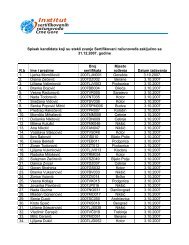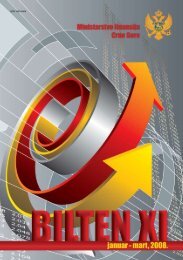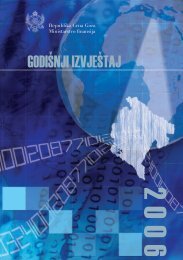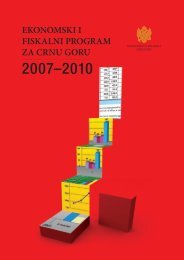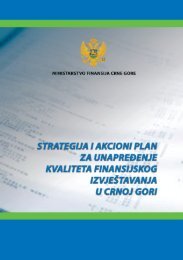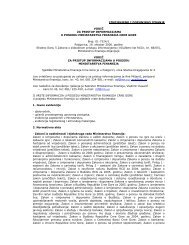Republic of Montenegro: Public Expenditure and ... - Vlada Crne Gore
Republic of Montenegro: Public Expenditure and ... - Vlada Crne Gore
Republic of Montenegro: Public Expenditure and ... - Vlada Crne Gore
You also want an ePaper? Increase the reach of your titles
YUMPU automatically turns print PDFs into web optimized ePapers that Google loves.
26<br />
Chapter 2: Composition <strong>of</strong> <strong>Public</strong> <strong>Expenditure</strong> <strong>and</strong><br />
Key Sources <strong>of</strong> Fiscal Pressure<br />
comparator countries (Table 2.7). The average annual salary <strong>of</strong> a teacher in <strong>Montenegro</strong>,<br />
including all the allowances is €7,103, which amounts to more than 160 percent <strong>of</strong> per capita<br />
GDP. This is very high in international terms.<br />
2.37 To make matters worse, average<br />
salaries for both teaching <strong>and</strong> non-teaching<br />
staff in non-university education increased<br />
by between 8 <strong>and</strong> 9 percent in 2006. This was<br />
the result <strong>of</strong> a new branch collective agreement<br />
which increased salary coefficients. The<br />
projected salary budget for these staff for 2006<br />
as against 2005 showed an increase <strong>of</strong> only<br />
three percent. This means the government<br />
faces a simple choice. Either, allow spending<br />
on salaries to eat further into the non-salary<br />
expenditures, which, as noted above, are<br />
already low, or, reduce the number<br />
2.38 <strong>of</strong> staff in the sector so that the overall<br />
wage bill fits within the projected budget. The<br />
Bank team has been advised that the<br />
government has adopted the second option.<br />
This means that the government needs to<br />
reduce wage expenditure in non-university<br />
education 29 from the approximately €65.9m it<br />
would be if all staff remained in the sector 30 to<br />
the €60.7m allocated in the Ministry’s budget<br />
Table 2.7. Average Teacher Salaries <strong>and</strong><br />
Benefits, as a Ratio <strong>of</strong> PPPGDP per Capita,<br />
2003<br />
<strong>Montenegro</strong> (2004) 1.61<br />
OECD Average 1.31<br />
Indonesia 0.50<br />
Slovak <strong>Republic</strong> 0.56<br />
Pol<strong>and</strong> 0.82<br />
Hungary 0.98<br />
Czech <strong>Republic</strong> 1.06<br />
Finl<strong>and</strong> 1.12<br />
France 1.12<br />
Peru 1.13<br />
United States 1.17<br />
Spain 1.42<br />
New Zeal<strong>and</strong> 1.51<br />
Germany 1.71<br />
Korea 2.42<br />
Note: For <strong>Montenegro</strong>, the figure is based on the<br />
average salary for all teachers; for other countries, the<br />
base is the average salary for primary education<br />
teachers with fifteen years <strong>of</strong> experience.<br />
PPP: Purchasing power parity<br />
Source: Education at a Glance 2005, Bank staff<br />
estimates for Bosnia <strong>and</strong> Herzegovina <strong>and</strong> <strong>Montenegro</strong>.<br />
for 2006. The Government has not said how it intends to reduce employment <strong>and</strong> the time for<br />
reductions before the beginning <strong>of</strong> the 2006-07 school year has passed. Had the reductions been<br />
made over the summer, a reduction in the 2006 wage bill <strong>of</strong> €5.2m would be equivalent to a<br />
reduction in education staff <strong>of</strong> 1,800. 31 In fact, even more savings are needed because making<br />
people redundant costs money. In 2005, the Government went through a redundancy program<br />
which <strong>of</strong>fered any teacher who wished to leave the pr<strong>of</strong>ession €2,000. These funds were paid<br />
from the budget <strong>of</strong> the Ministry <strong>of</strong> Labor <strong>and</strong> Social Welfare. If this same approach were<br />
adopted in 2006, it would mean that the net savings to the government in 2006 from each person<br />
29 The university is excluded from these calculations because no information is available on spending allocations, as<br />
the government gives a lump sum transfer to the university which covers all types <strong>of</strong> spending.<br />
30 Assuming an average salary increase <strong>of</strong> 8.5 percent.<br />
31 The average gross salary including allowances <strong>of</strong> staff (including both teaching <strong>and</strong> non-teaching) is estimated to<br />
be €5,780 (for just teachers, €7,103). This implies that for each person made redundant the total savings in 2006<br />
will be €2,890 (€3,557), since staff can now only be released from their duties at the end <strong>of</strong> the school year (i.e.,<br />
after six months work in 2006).




